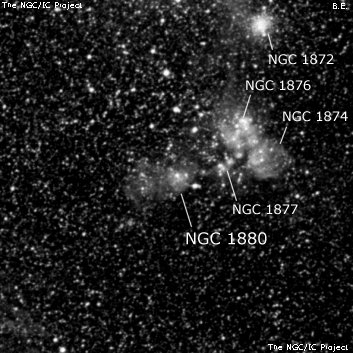
John Herschel discovered NGC 1880 = h2808 in Dec 1834 and described as "A fourth nucleus at the southern end of the arc-formed nebula and cluster, as laid down in the figure of Jan 17, 1838 [plate III, figure 6 in the CGH Observations]." This grouping consists of NGC 1872, 1874, 1877 and NGC 1880. See Corwin's notes for NGC 1874.
James Dunlop probably discovered the complex earlier in 1826 with his 9-inch reflector. He reported D 122 as "a small nebula, about 20" diameter, with three smaller nebulae following, and three pretty bright small stars on the north side". His position of 14' S of the NGC 1874/1876/1877/1880 complex, so he probably saw several of these, but it's not certain whichh ones he noticed.
600/800mm - 24" (4/5/08 - Magellan Observatory, Australia): this is the 4th in a striking group of HII regions with the main complex consisting of NGC 1874, 1876 and 1877 just to the west by 2'-3'. At 200x with a UHC filter NGC 1880 appeared as a moderately bright, small, round haze surrounding a star. A brighter mag 12.3 star ~40" SW is free of nebulosity. Very faint haze is visible extending to the east (BSDL 945) and northeast.
Notes by Steve Gottlieb